oil PORSCHE CAYMAN 2006 1.G Information Manual
[x] Cancel search | Manufacturer: PORSCHE, Model Year: 2006, Model line: CAYMAN, Model: PORSCHE CAYMAN 2006 1.GPages: 61, PDF Size: 2.24 MB
Page 8 of 61
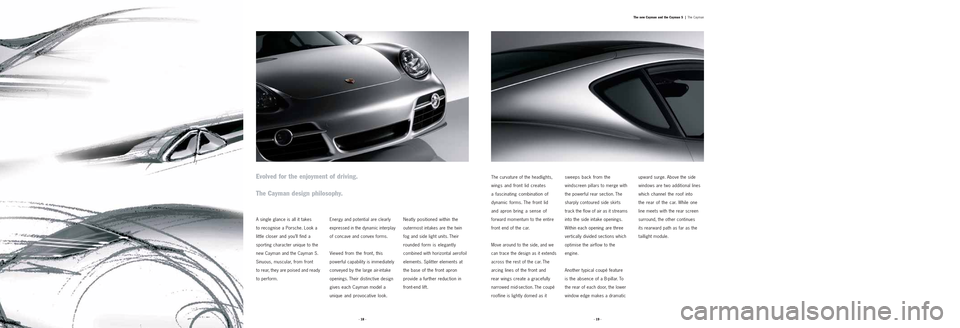
· 19 ·The new Cayman and the Cayman S |
The Cayman
upward surge. Above the side
windows are two additional lines
which channel the roof into
the rear of the car. While one
line meets with the rear screen
surround, the other continues
its rearward path as far as the
taillight module.
sweeps back from the
windscreen pillars to merge with
the powerful rear section. The
sharply contoured side skirts
track the flow of air as it streams
into the side intake openings.
Within each opening are three
vertically divided sections which
optimise the airflow to the
engine.
Another typical coupé feature
is the absence of a B-pillar. To
the rear of each door, the lower
window edge makes a dramatic The curvature of the headlights,
wings and front lid creates
a fascinating combination of
dynamic forms. The front lid
and apron bring a sense of
forward momentum to the entire
front end of the car.
Move around to the side, and we
can trace the design as it extends
across the rest of the car. The
arcing lines of the front and
rear wings create a gracefully
narrowed mid-section. The coupé
roofline is lightly domed as it
· 18 ·
Evolved for the enjoyment of driving.
The Cayman design philosophy.
A single glance is all it takes
to recognise a Porsche. Look a
little closer and you’ll find a
sporting character unique to the
new Cayman and the Cayman S.
Sinuous, muscular, from front
to rear, they are poised and ready
to perform.Energy and potential are clearly
expressed in the dynamic interplay
of concave and convex forms.
Viewed from the front, this
powerful capability is immediately
conveyed by the large air-intake
openings. Their distinctive design
gives each Cayman model a
unique and provocative look.
Neatly positioned within the
outermost intakes are the twin
fog and side light units. Their
rounded form is elegantly
combined with horizontal aerofoil
elements. Splitter elements at
the base of the front apron
provide a further reduction in
front-end lift.
Page 9 of 61
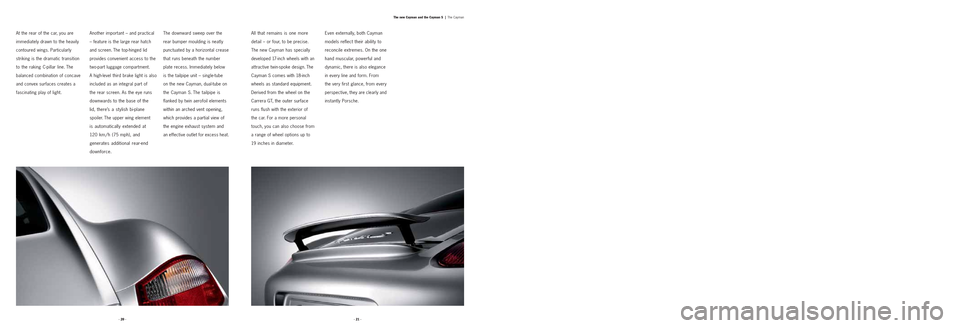
· 21 · · 20 ·
At the rear of the car, you are
immediately drawn to the heavily
contoured wings. Particularly
striking is the dramatic transition
to the raking C-pillar line. The
balanced combination of concave
and convex surfaces creates a
fascinating play of light.Another important – and practical
– feature is the large rear hatch
and screen. The top-hinged lid
provides convenient access to the
two-part luggage compartment.
A high-level third brake light is also
included as an integral part of
the rear screen. As the eye runs
downwards to the base of the
lid, there’s a stylish bi-plane
spoiler. The upper wing element
is automatically extended at
120 km / h (75 mph), and
generates additional rear-end
downforce.
The downward sweep over the
rear bumper moulding is neatly
punctuated by a horizontal crease
that runs beneath the number
plate recess. Immediately below
is the tailpipe unit – single-tube
on the new Cayman, dual-tube on
the Cayman S. The tailpipe is
flanked by twin aerofoil elements
within an arched vent opening,
which provides a partial view of
the engine exhaust system and
an effective outlet for excess heat.
All that remains is one more
detail – or four, to be precise.
The new Cayman has specially
developed 17-inch wheels with an
attractive twin-spoke design. The
Cayman S comes with 18-inch
wheels as standard equipment.
Derived from the wheel on the
Carrera GT, the outer surface
runs flush with the exterior of
the car. For a more personal
touch, you can also choose from
a range of wheel options up to
19 inches in diameter.
Even externally, both Cayman
models reflect their ability to
reconcile extremes. On the one
hand muscular, powerful and
dynamic, there is also elegance
in every line and form. From
the very first glance, from every
perspective, they are clearly and
instantly Porsche.
The new Cayman and the Cayman S |The Cayman
Page 11 of 61
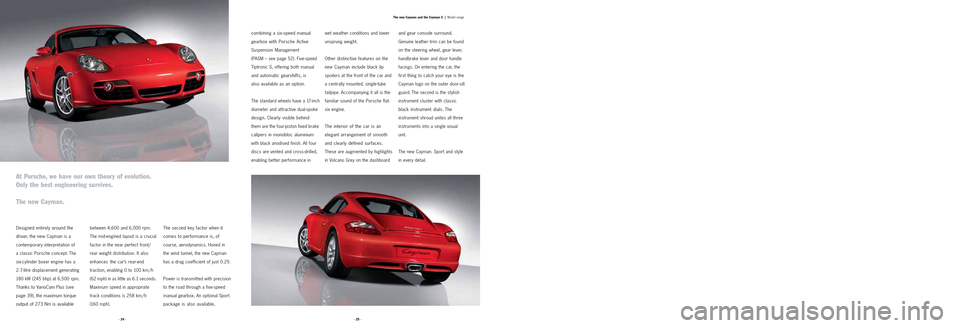
· 25 ·
Designed entirely around the
driver, the new Cayman is a
contemporary interpretation of
a classic Porsche concept. The
six-cylinder boxer engine has a
2.7-litre displacement generating
180 kW (245 bhp) at 6,500 rpm.
Thanks to VarioCam Plus (see
page 39), the maximum torque
output of 273 Nm is available
between 4,600 and 6,000 rpm.
The mid-engined layout is a crucial
factor in the near perfect front/
rear weight distribution. It also
enhances the car’s rear-end
traction, enabling 0 to 100 km / h
(62 mph) in as little as 6.1 seconds.
Maximum speed in appropriate
track conditions is 258 km / h
(160 mph).
The second key factor when it
comes to performance is, of
course, aerodynamics. Honed in
the wind tunnel, the new Cayman
has a drag coefficient of just 0.29.
Power is transmitted with precision
to the road through a five-speed
manual gearbox. An optional Sport
package is also available,
The new Cayman and the Cayman S |Model range
combining a six-speed manual
gearbox with Porsche Active
Suspension Management
(PASM – see page 52). Five-speed
Tiptronic S, offering both manual
and automatic gearshifts, is
also available as an option.
The standard wheels have a 17-inch
diameter and attractive dual-spoke
design. Clearly visible behind
them are the four-piston fixed brake
calipers in monobloc aluminium
with black anodised finish. All four
discs are vented and cross-drilled,
enabling better performance in wet weather conditions and lower
unsprung weight.
Other distinctive features on the
new Cayman include black lip
spoilers at the front of the car and
a centrally mounted, single-tube
tailpipe. Accompanying it all is the
familiar sound of the Porsche flat-
six engine.
The interior of the car is an
elegant arrangement of smooth
and clearly defined surfaces.
These are augmented by highlights
in Volcano Grey on the dashboard
At Porsche, we have our own theory of evolution.
Only the best engineering survives.
The new Cayman.
· 24 ·
and gear console surround.
Genuine leather trim can be found
on the steering wheel, gear lever,
handbrake lever and door handle
facings. On entering the car, the
first thing to catch your eye is the
Cayman logo on the outer door-sill
guard. The second is the stylish
instrument cluster with classic
black instrument dials. The
instrument shroud unites all three
instruments into a single visual
unit.
The new Cayman. Sport and style
in every detail.
Page 12 of 61
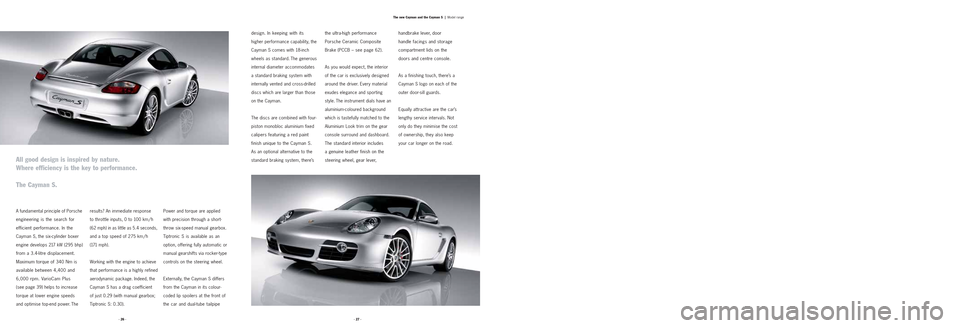
· 27 · · 26 ·
A fundamental principle of Porsche
engineering is the search for
efficient performance. In the
Cayman S, the six-cylinder boxer
engine develops 217 kW (295 bhp)
from a 3.4-litre displacement.
Maximum torque of 340 Nm is
available between 4,400 and
6,000 rpm. VarioCam Plus
(see page 39) helps to increase
torque at lower engine speeds
and optimise top-end power. Theresults? An immediate response
to throttle inputs, 0 to 100 km / h
(62 mph) in as little as 5.4 seconds,
and a top speed of 275 km / h
(171 mph).
Working with the engine to achieve
that performance is a highly refined
aerodynamic package. Indeed, the
Cayman S has a drag coefficient
of just 0.29 (with manual gearbox;
Tiptronic S: 0.30).
Power and torque are applied
with precision through a short-
throw six-speed manual gearbox.
Tiptronic S is available as an
option, offering fully automatic or
manual gearshifts via rocker-type
controls on the steering wheel.
Externally, the Cayman S differs
from the Cayman in its colour-
coded lip spoilers at the front of
the car and dual-tube tailpipe
The new Cayman and the Cayman S |Model range
design. In keeping with its
higher performance capability, the
Cayman S comes with 18-inch
wheels as standard. The generous
internal diameter accommodates
a standard braking system with
internally vented and cross-drilled
discs which are larger than those
on the Cayman.
The discs are combined with four-
piston monobloc aluminium fixed
calipers featuring a red paint
finish unique to the Cayman S.
As an optional alternative to the
standard braking system, there’s
the ultra-high performance
Porsche Ceramic Composite
Brake (PCCB – see page 62).
As you would expect, the interior
of the car is exclusively designed
around the driver. Every material
exudes elegance and sporting
style. The instrument dials have an
aluminium-coloured background
which is tastefully matched to the
Aluminium Look trim on the gear
console surround and dashboard.
The standard interior includes
a genuine leather finish on the
steering wheel, gear lever,
All good design is inspired by nature.
Where efficiency is the key to performance.
The Cayman S.
handbrake lever, door
handle facings and storage
compartment lids on the
doors and centre console.
As a finishing touch, there’s a
Cayman S logo on each of the
outer door-sill guards.
Equally attractive are the car’s
lengthy service intervals. Not
only do they minimise the cost
of ownership, they also keep
your car longer on the road.
Page 16 of 61

The new Cayman and the Cayman S |Drive
· 34 ·
1. Oil scavenge pump (obscured)
2. Individual ignition coil
3. Camshaft adjuster (valve timing)
4. Control valve for camshaft adjuster
5. Control valve for variable valve lift
6. Inlet camshaft
7. Switchable tappet with hydraulic valve
clearance adjustment
8. Inlet valve
9. Valve spring
10. Exhaust valve
11. Lokasil-coated bore
12. Forged aluminium piston
13. Forged connecting rod
14. Crankshaft bearing bridge
15. Crankshaft
16. Water jacket
17. Combustion chamber
18. Electronically controlled throttle valve
19. Resonance intake manifold
20. Twin-flow intake pipe
21. Twin-flow intake valve
22. Resonance valve
23. Air-conditioning compressor pulley
24. Power-steering pump pulley
25. Ancillary drive belt
26. Water pump pulley
27. Oil feed pump (obscured)
28. Tandem pump
1
2
3
5
4
6
78
15
16
17
18
19
20
21
22
23
24
25
26
2728
14
9
1011
12
13
· 35 · · 34 · 3.4-litre six-cylinder boxer engine (Cayman S)
Page 17 of 61
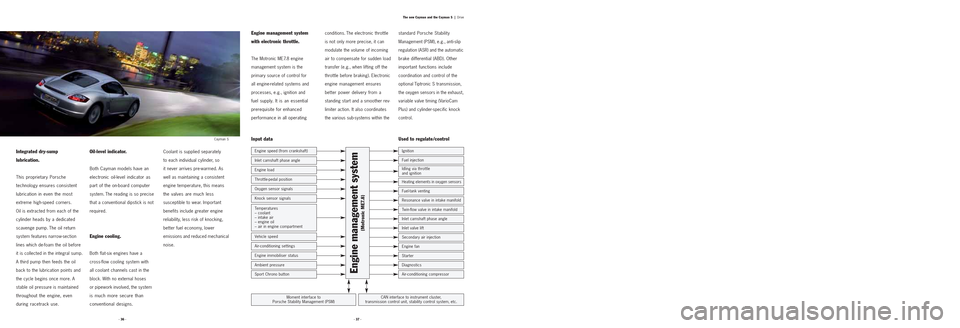
· 37 · · 36 ·The new Cayman and the Cayman S |
Drive
Integrated dry-sump
lubrication.
This proprietary Porsche
technology ensures consistent
lubrication in even the most
extreme high-speed corners.
Oil is extracted from each of the
cylinder heads by a dedicated
scavenge pump. The oil return
system features narrow-section
lines which de-foam the oil before
it is collected in the integral sump.
A third pump then feeds the oil
back to the lubrication points and
the cycle begins once more. A
stable oil pressure is maintained
throughout the engine, even
during racetrack use.
Oil-level indicator.
Both Cayman models have an
electronic oil-level indicator as
part of the on-board computer
system. The reading is so precise
that a conventional dipstick is not
required.
Engine cooling.
Both flat-six engines have a
cross-flow cooling system with
all coolant channels cast in the
block. With no external hoses
or pipework involved, the system
is much more secure than
conventional designs.
Coolant is supplied separately
to each individual cylinder, so
it never arrives pre-warmed. As
well as maintaining a consistent
engine temperature, this means
the valves are much less
susceptible to wear. Important
benefits include greater engine
reliability, less risk of knocking,
better fuel economy, lower
emissions and reduced mechanical
noise.
Engine management system
with electronic throttle.
The Motronic ME7.8 engine
management system is the
primary source of control for
all engine-related systems and
processes, e.g., ignition and
fuel supply. It is an essential
prerequisite for enhanced
performance in all operating
conditions. The electronic throttle
is not only more precise, it can
modulate the volume of incoming
air to compensate for sudden load
transfer (e.g., when lifting off the
throttle before braking). Electronic
engine management ensures
better power delivery from a
standing start and a smoother rev-
limiter action. It also coordinates
the various sub-systems within the
Used to regulate /control
Engine management system
(Motronic ME7.8)
Engine load
Throttle-pedal position
Oxygen sensor signals
Engine speed (from crankshaft)
Inlet camshaft phase angle
Knock sensor signals
Vehicle speed
Air-conditioning settings
Engine immobiliser status
Ambient pressure
Sport Chrono button
Temperatures
– coolant
– intake air
– engine oil
– air in engine compartment
Ignition
Fuel injection
Idling via throttle
and ignition
Heating elements in oxygen sensors
Fuel-tank venting
CAN interface to instrument cluster,
transmission control unit, stability control system, etc.Moment interface to
Porsche Stability Management (PSM)
Input data
Twin-flow valve in intake manifold
Resonance valve in intake manifold
Inlet camshaft phase angle
Inlet valve lift
Secondary air injection
Engine fan
Starter
Diagnostics
Air-conditioning compressor
standard Porsche Stability
Management (PSM), e.g., anti-slip
regulation (ASR) and the automatic
brake differential (ABD). Other
important functions include
coordination and control of the
optional Tiptronic S transmission,
the oxygen sensors in the exhaust,
variable valve timing (VarioCam
Plus) and cylinder-specific knock
control.
Cayman S
Page 19 of 61
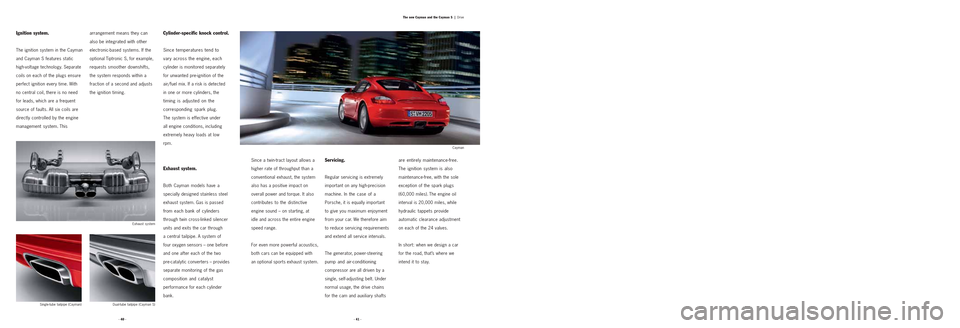
· 41 · · 40 ·The new Cayman and the Cayman S |
Drive
Ignition system.
The ignition system in the Cayman
and Cayman S features static
high-voltage technology. Separate
coils on each of the plugs ensure
perfect ignition every time. With
no central coil, there is no need
for leads, which are a frequent
source of faults. All six coils are
directly controlled by the engine
management system. This
Cylinder-specific knock control.
Since temperatures tend to
vary across the engine, each
cylinder is monitored separately
for unwanted pre-ignition of the
air/fuel mix. If a risk is detected
in one or more cylinders, the
timing is adjusted on the
corresponding spark plug.
The system is effective under
all engine conditions, including
extremely heavy loads at low
rpm.
Exhaust system.
Both Cayman models have a
specially designed stainless steel
exhaust system. Gas is passed
from each bank of cylinders
through twin cross-linked silencer
units and exits the car through
a central tailpipe. A system of
four oxygen sensors – one before
and one after each of the two
pre-catalytic converters – provides
separate monitoring of the gas
composition and catalyst
performance for each cylinder
bank.
arrangement means they can
also be integrated with other
electronic-based systems. If the
optional Tiptronic S, for example,
requests smoother downshifts,
the system responds within a
fraction of a second and adjusts
the ignition timing.
Since a twin-tract layout allows a
higher rate of throughput than a
conventional exhaust, the system
also has a positive impact on
overall power and torque. It also
contributes to the distinctive
engine sound – on starting, at
idle and across the entire engine
speed range.
For even more powerful acoustics,
both cars can be equipped with
an optional sports exhaust system.
Servicing.
Regular servicing is extremely
important on any high-precision
machine. In the case of a
Porsche, it is equally important
to give you maximum enjoyment
from your car. We therefore aim
to reduce servicing requirements
and extend all service intervals.
The generator, power-steering
pump and air-conditioning
compressor are all driven by a
single, self-adjusting belt. Under
normal usage, the drive chains
for the cam and auxiliary shafts
are entirely maintenance-free.
The ignition system is also
maintenance-free, with the sole
exception of the spark plugs
(60,000 miles). The engine oil
interval is 20,000 miles, while
hydraulic tappets provide
automatic clearance adjustment
on each of the 24 valves.
In short: when we design a car
for the road, that’s where we
intend it to stay.Exhaust system
Dual-tube tailpipe (Cayman S) Single-tube tailpipe (Cayman)Cayman
Page 20 of 61

· 43 · · 42 ·
1
1
6
5
3
10
10
9
8
7
13
12
4
11 2
gearbox is supported laterally by
two additional mounts. All three
mounts are hydraulic in design,
using a fluid-filled element to
dampen vibration and noise. The
mounts are effective against both
high and low-frequency vibration.6. Resonance intake manifold
7. Coolant expansion tank
8. Electronically controlled
throttle valve
9. Connecting duct
10. Silencer11. Connecting tube
12. Oil filler neck
13. Air filter intake duct 1. Radiator module
2. Brake booster
3. Gearshift /gear selector lug
4. PASM damper
5. 6-speed manual gearbox/
5-speed Tiptronic S Engine and gearbox mounts.
Both Cayman models use a
system of three hydraulic mounts
to support the engine and
gearbox. The engine is held by
a single mount located centrally
at the front of the unit. The
The new Cayman and the Cayman S |Drive
Cayman S
Page 23 of 61
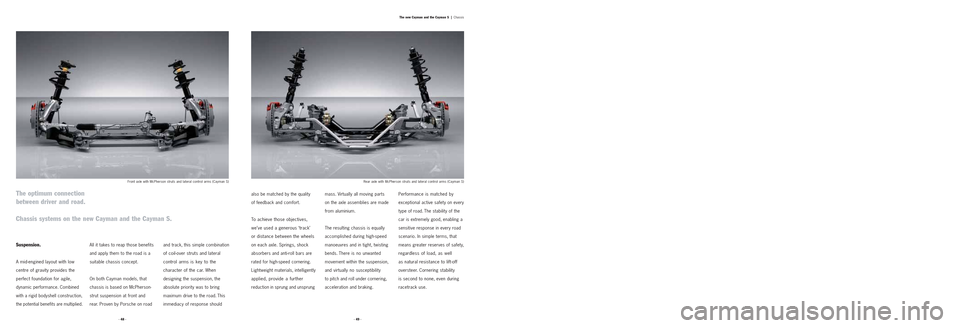
· 48 ·Rear axle with McPherson struts and lateral control arms (Cayman S) Front axle with McPherson struts and lateral control arms (Cayman S)The new Cayman and the Cayman S |
Chassis
Suspension.
A mid-engined layout with low
centre of gravity provides the
perfect foundation for agile,
dynamic performance. Combined
with a rigid bodyshell construction,
the potential benefits are multiplied.
All it takes to reap those benefits
and apply them to the road is a
suitable chassis concept.
On both Cayman models, that
chassis is based on McPherson-
strut suspension at front and
rear. Proven by Porsche on roadand track, this simple combination
of coil-over struts and lateral
control arms is key to the
character of the car. When
designing the suspension, the
absolute priority was to bring
maximum drive to the road. This
immediacy of response shouldalso be matched by the quality
of feedback and comfort.
To achieve those objectives,
we’ve used a generous ‘track’
or distance between the wheels
on each axle. Springs, shock
absorbers and anti-roll bars are
rated for high-speed cornering.
Lightweight materials, intelligently
applied, provide a further
reduction in sprung and unsprungmass. Virtually all moving parts
on the axle assemblies are made
from aluminium.
The resulting chassis is equally
accomplished during high-speed
manoeuvres and in tight, twisting
bends. There is no unwanted
movement within the suspension,
and virtually no susceptibility
to pitch and roll under cornering,
acceleration and braking.
Performance is matched by
exceptional active safety on every
type of road. The stability of the
car is extremely good, enabling a
sensitive response in every road
scenario. In simple terms, that
means greater reserves of safety,
regardless of load, as well
as natural resistance to lift-off
oversteer. Cornering stability
is second to none, even during
racetrack use.
The optimum connection
between driver and road.
Chassis systems on the new Cayman and the Cayman S.
· 49 ·
Page 28 of 61
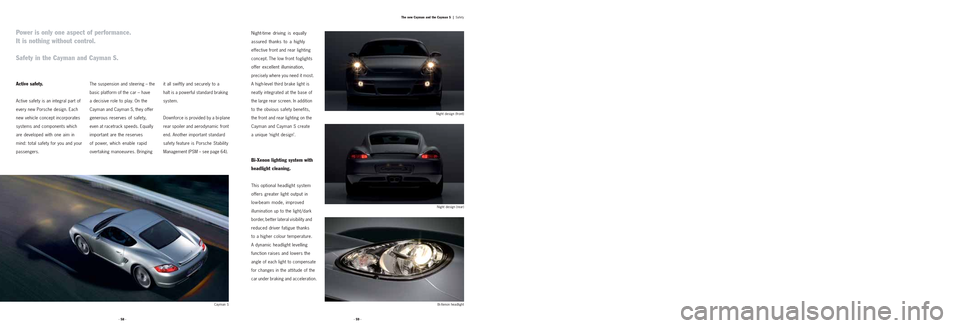
· 59 · · 58 ·The new Cayman and the Cayman S |
Safety
Power is only one aspect of performance.
It is nothing without control.
Safety in the Cayman and Cayman S.
Active safety.
Active safety is an integral part of
every new Porsche design. Each
new vehicle concept incorporates
systems and components which
are developed with one aim in
mind: total safety for you and your
passengers.The suspension and steering – the
basic platform of the car – have a decisive role to play. On the
Cayman and Cayman S, they offer
generous reserves of safety,
even at racetrack speeds. Equally
important are the reserves
of power, which enable rapid
overtaking manoeuvres. Bringing
Night-time driving is equally
assured thanks to a highly
effective front and rear lighting
concept. The low front foglights
offer excellent illumination,
precisely where you need it most.
A high-level third brake light is
neatly integrated at the base of
the large rear screen. In addition
to the obvious safety benefits,
the front and rear lighting on the
Cayman and Cayman S create
a unique ‘night design’.
Bi-Xenon lighting system with
headlight cleaning.
This optional headlight system
offers greater light output in
low-beam mode, improved
illumination up to the light/dark
border, better lateral visibility and
reduced driver fatigue thanks
to a higher colour temperature.
A dynamic headlight levelling
function raises and lowers the
angle of each light to compensate
for changes in the attitude of the
car under braking and acceleration.
Night design (rear)
Bi-Xenon headlight Night design (front)
Cayman S
it all swiftly and securely to a
halt is a powerful standard braking
system.
Downforce is provided by a bi-plane
rear spoiler and aerodynamic front
end. Another important standard
safety feature is Porsche Stability
Management (PSM – see page 64).